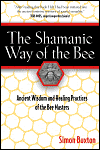
Some years ago when author Elizabeth Cunningham told me about the Blessed Bees, I was so taken with the idea of the pun on the Wiccan “blessed be” that I put the Bees in my book, Finding New Goddesses. The Blessed Bees are Found power animals:
Twinkle, Twinkle, Blessed Bees,
As I ask you, grant it please.
Wisdom, wealth, abundancies,
As I will’t, so mote it, Bees.
Now along comes an Englishman named Simon Buxton writing about a heretofore totally unknown shamanic tradition of bee wisdom “developed by the ancient races of the British Isles and Europe. It is a little-known form of Keltic shamanism…” (p. 10). Who knew?
As a child in Austria, Buxton fell ill and was healed by the mysterious Herr Professor, a bee keeper. A decade later, living in the south of England, Buxton encounters Bridge, another bee keeper. Bridge (he says the name is a translation of a phrase in the Mabinogion) is a shaman and Bee Master who delivers Knowledge Lectures (“The Bee Master knows….”) to the author. Among other things, the Bee Master says that “the bee stands for—and is a manifestation of—the fundamental verb ‘to be.’ ‘I am, thou art, he is’ it declares as it goes humming by” (p. 30). Bridge says that the Cornish beu, the Irish beo, and the Welsh byw “can all be translated as ‘alive’ or ‘living,’” and that the Greek bios is another related word. The Oxford English Dictionary tells us that the word “bee” came into English via the Old Teutonic from an Indo-European root, bi or bhi, and “means ‘to fear’ in the sense of ‘quivering’ or ‘buzzing.’” The OED further tells us that bees are of the order hymenoptera.
Very soon, the Bee Master is calling Buxton “Twig” because he is “a small branch of the great tree.” (Does this remind anyone else of “Grasshopper”?) Buxton takes us through his bee initiation. When Bridge induces bees to sting him on his head and at his third eye, the venom does its work. Twig awakens in a hive as a drone. He flies out and mates with the queen bee and dies, to be reborn in another place of mystery. This turns out to be a six-sided wicker basket about three feet in diameter with a blanket over the top. Twig lies in there, curled up on a bed of beeswax, and listens to additional lectures from the Bee Master and Bee Mistress on topics like the significance of the lemniscate (eternity sign), which is the dance of the bee. Twig spends twenty-three days in the basket, the same length of time a drone spends in a hive. Later, in the name of Vitamin Pan [sic.], Buxton stalks and traps a stag and kills it by smothering it with pollen.
We know, of course, that bees have long been considered sacred, that the bee is one ancient symbol of the Goddess, and that the melissae were Her priestesses in Greece. One melissa fed honey to Zeus when he was an infant in Crete. In Starhawk’s novel, The Fifth Sacred Thing, there is a group of healers that work with bee magic and the Little Sisters and are called Melissas. A scene in chapter 14 shows a healing when the Melissa feeds propolis to a wounded man. In Buxton’s book, by contrast, his melissae are strange, almost alien women (like from outer space). He invokes no goddess and does no work for the community. He neither heals nor helps anyone. It’s possible to find wisdom in nearly any book, but when I checked with scholars of Celtic and European culture, they told me that they’d never heard of the Path of Pollen and that, except for Gobnait, bees rarely appear in Celtic mythology.
If you want dependable bee history and lore, including information on so-called killer bees, see chapter 9 of Joanne Elizabeth Lauck’s The Voice of the Infinite in the Small. You can also find bee lore, Black Virgins, and a good story in Sue Monk Kidd’s popular novel, The Secret Life of Bees. It’s probably best to read Buxton’s book as magical or shamanic fiction.
~review by Barbara Ardinger, Ph.D.
Author: Simon Buxton
Destiny Books, 2004
pp. 206, $20
